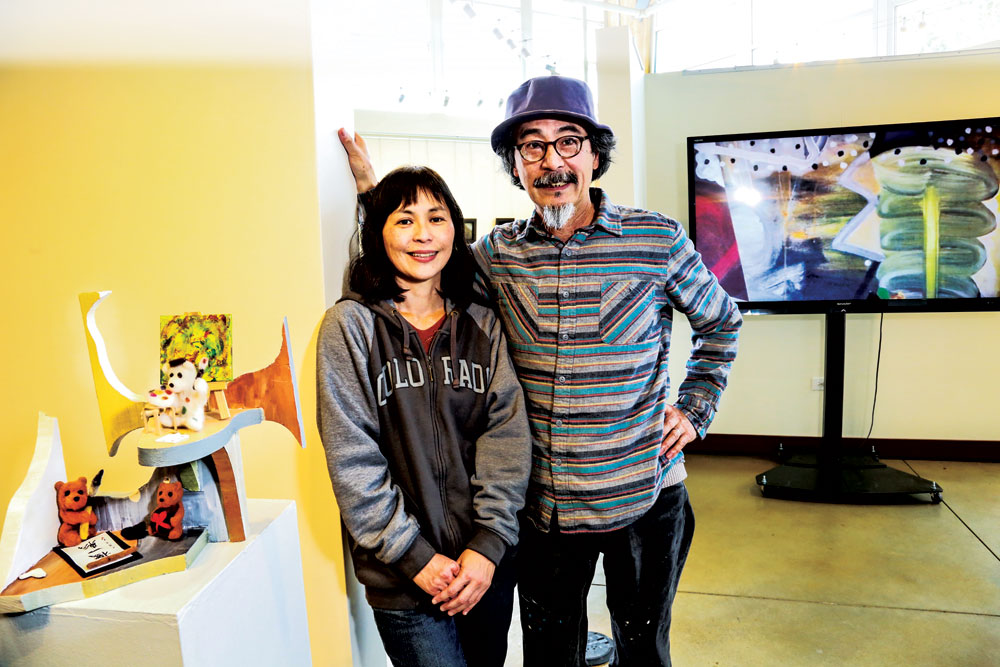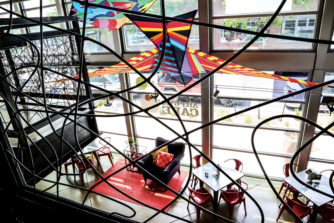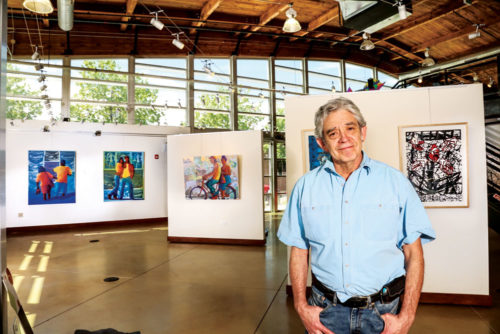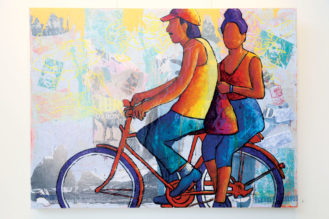
Mamiko Ikeda is a poet, calligrapher and musician. Her husband Homare Ikeda is an abstract painter who has paintings in the permanent collection at the Denver Art Museum.
The Art Gym, a do-it-yourself creative workspace and gallery in Mayfair, presents Alone + Together, a free exhibition featuring the work of three Denver artist couples, through May 20.
The three couples will show both their own work and collaborative work created with their partner. The artwork includes painting, calligraphy, video installation, photography, printmaking, collage, pastel, mixed media and musical performances.
The 17,000-square-foot Art Gym, which was previously a Safeway, opened in 2015. Members pay $100 per month for access to studio space and specialty tools. Art Gym is at 1460 Leyden St. The gallery and coffee shop/café are open to visitors Tues. through Sat., 9am–6pm. For more information, see artgymdenver.com or call 303.320.8347.
Alone + Together artist couples talked with the Front Porch about their lives and their art.

The Art Gym Café/coffee shop is open Tuesday through Saturday 9am until 6pm.
Mamiko and Homare Ikeda
The Ikedas will show their collaborative video work that joins his painting and drawing with her calligraphy, animation and music. The three videos will include an animated cartoon in which they are characters.
Homare, from a small island near Okinawa, and Mamiko, from Tokyo, met in Denver and married in 2000. Homare is a respected abstract painter whose work is in the permanent collection of the Denver Art Museum. Mamiko is a poet, calligrapher and musician who became inspired to ramp up her creative work when she was exposed to Homare’s paintings.
Most of Homare’s work is inspired by the sea. “The sea is a metaphor for the primordial beginning of the universe,” he said. “Being in Denver brings out my longing for the sea—a nostalgia that incorporates not just my memories but mankind’s.”
He said hiking in the mountains also inspires his work because he considers himself an explorer. “The mountains reach higher than the sky, to the unknown,” he said. “I hope people who see my work will see something they haven’t seen before. The task of visual art is to reveal things you haven’t seen.”
Mamiko earned a master’s degree from the University of Denver in liberal arts, specializing in American Indian Studies. “The Indians and the Japanese are connected in a way; they are relatives from long ago, when they traveled across the sea. My art is influenced by the American Indian stories and beliefs.”
Homare’s paintings inspire their collaboration, she said. “I am surrounded by his art and my stories and poems come out of it.”
Mamiko will perform the original songs featured in the videos on May 13 from 2–4pm, accompanied by Harry Tulchin on mandolin. They will also perform Japanese and Okinawan songs featuring the sanshin, a traditional three-stringed Okinawan instrument.
Tony Ortega and Sylvia Montero

Tony Ortega is an associate professor at Regis University. Over his shoulder is a painting by his wife Sylvia Montero.
Tony Ortega and Sylvia Montero will show three pieces all about couples. “One is a couple on a bicycle; another is a couple holding hands. They are all about relationships between males and females,” says Ortega.
Montero and Ortega, married since 1992, have a son, 26. Their studio is a 600-foot addition to their home. Ortega is an associate professor at Regis University and Montero teaches at Whittier Elementary and CMS Community School.
The couple’s art centers around the culture and experiences of Chicanos and Latinos in the U.S. “We met when Sylvia was working at the Chicano Humanities and Arts Council [a gallery and arts center] and I was renting studio space there,” said Ortega. “Our artistic tendencies attracted us to each other. She was a dancer who got into fine art.”
The couple shares a background in the Chicano/Chicana movement of the 1970s in Denver. Their art reflects their bicultural roots. Ortega’s colorful acrylic-with-collage paintings incorporate various cultural images, including the Statue of liberty and Our Lady of Guadalupe. “The images are pulled from both cultures, overlapped and juxtaposed to make social statements,” he said.

A piece of Ortega’s couples art is shown at the Art Gym exhibit.
Montero favors other symbols in her paint-on-paper/mixed media/collage pieces. “Where I use pop iconography like Mickey Mouse and Che Guevara, Sylvia uses flowers, hearts and indigenous markets to reflect her upbringing in Northwest Denver and our universal Native American roots,” said Ortega.
Sharing their studio space gives them an opportunity to share ideas, said Ortega. “Sharing space has made our relationship stronger. We talk about teaching and about our art ideas. We critique each other’s art too. We don’t always agree, but that’s all right.”
As part of the exhibition, Ortega will demonstrate mono printing on May 6, from 2–4pm. A mono print is a single impression of an image made from a re-printable block. The paper and plate are pressed together on a printmaking press with the pigment sandwiched in-between. As the paper is peeled off the still-wet plate, the final result may look quite different than the image on the plate.
During his sabbatical next year, Ortega will be an artist-in-residence at Art Gym, where he will work with master printer Greg Santos. The artwork, to be exhibited in April 2018, will be a series combining the use of hybrid acrylic/collage paintings with prints using iPad technology and Adobe Photoshop. Art Gym will provide access to specialty tools and workspaces. “The artworks will express a correlation and contrast between Chicano (Mexican American) culture and popular culture. This research/creative project will allow me to create and develop new ideas and new methods of artistic expression,” said Ortega.
Mark Sink and Kristen Hatgi Sink
“We are each other’s muses,” says Kristen Hatgi Sink of her work alongside her husband, Mark Sink. The photographer couple will exhibit portraits of each other at the Art Gym show. “The show is about our mutual admiration and collaboration. I hope people see our love for image-making and for each other.”
Mark Sink has made a living from fine art photography since 1978. His photography is shown and collected worldwide. He is a co-founder of The Museum of Contemporary Art Denver, and founder of the Month of Photography Denver and The Big Picture street art projects.
Kristen Hatgi Sink is a visual artist and photographer with exhibit credits worldwide.
The couple has been together 12 years and has a daughter, Poppy, 14 months old. “We met when Kristen came to work at my photography gallery and never left,” says Mark.
Mark and Kristen collaborate on photos made with the collodion wet plate process, invented in the mid-19th century. “Images from the time of the Civil War were made that way,” said Kristen. “Photographers developed the photos in a wagon on-site, because the plates are wet with silver nitrate and have to be developed within about five minutes, one at a time.”
Exposure time is much longer than with modern photography. “It slows us down and makes us look more carefully,” said Mark. “It’s interesting that when a model sits still for a long exposure, the portrait has more presence. It’s a study in beauty.”
The staged photos are based in portrait theory, Mark said. “The power of a simple portrait speaks to the heart rather than the head.”
The Sinks’ collaboration includes critiquing each other’s work and celebrating their successes. “We know when something works,” Mark said. “We call it ‘dancing in the darkroom.’”




0 Comments